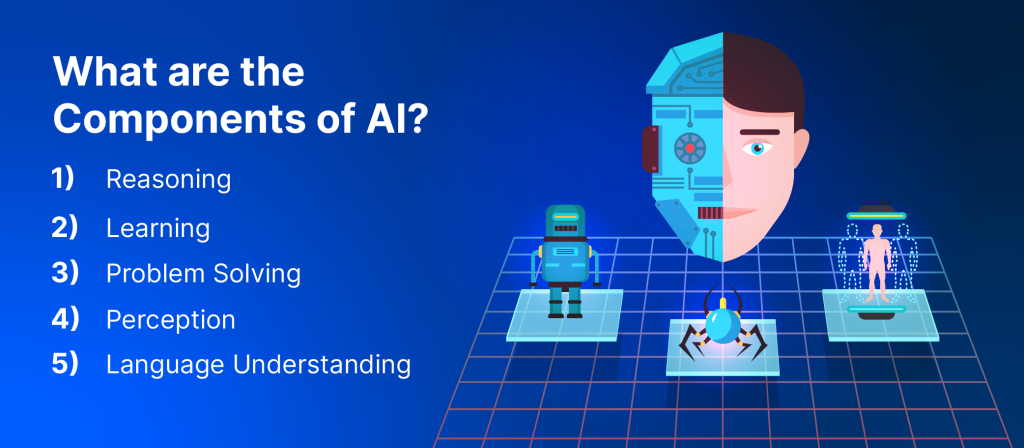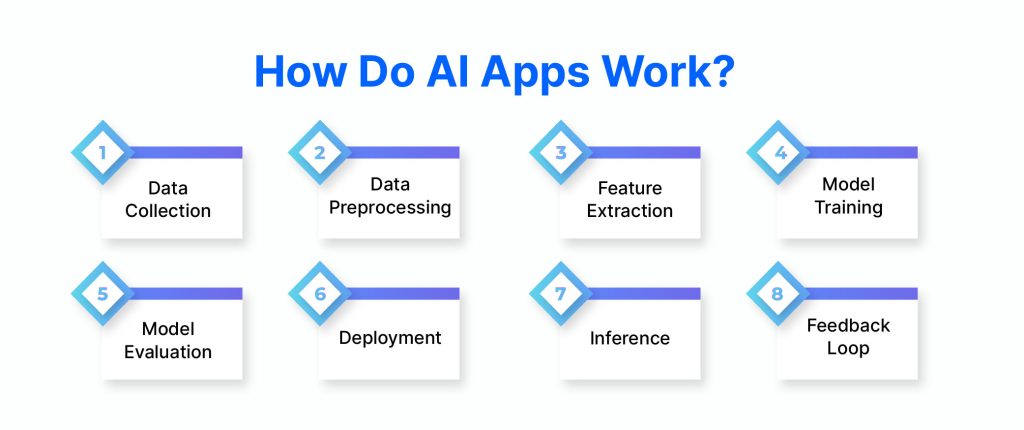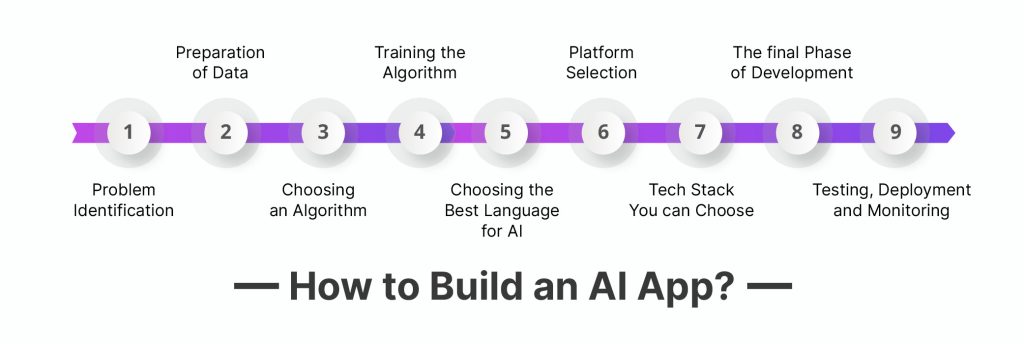When teams operate independently, it creates communication gaps that can lead to disorder. In contrast, when teams collaborate, they tend to be more efficient.
The artificial intelligence (AI) market is expected to reach US$ 1,597.1 billion by 2030, from an estimated US$ 119.78 billion in 2022. With a projected CAGR of 38.1 percent between 2022 and 2030, this is the case. As of 2021, the artificial intelligence market in North America was valued at USD 147.58 billion.
Artificial intelligence (AI) has entered every aspect of our life, from precise robots to driverless vehicles that are revolutionizing transportation. From massive production facilities to the little screens on our smartwatches, it is now a necessary component of everything. Businesses of all shapes and sizes are using AI these days to increase sales and enhance customer happiness. The next big thing, artificial intelligence (AI), is already making its way into Fortune 500 firms’ internal operations to help them automate business procedures. For companies trying to maintain their competitiveness in a fast-paced commercial environment, investing in AI might be advantageous. Master the fundamentals of AI development and unlock the potential to create cutting-edge AI apps with ease.
Artificial intelligence (AI) is a branch of computer science that aims to solve cognitive tasks related to human intellect, like learning, problem-solving, and pattern recognition. Artificial Intelligence (AI) is the application of cutting-edge technologies, such robotics, in futuristic settings. Although the term “artificial intelligence” has been defined in a variety of ways, John McCarthy defines it as “the science and engineering of making intelligent machines, especially intelligent computer programs” in his 2004 study. Although the aim of using computers to comprehend human intelligence is similar, artificial intelligence (AI) is not limited to techniques that may be observed through biological means. Artificial intelligence app development is at the forefront of technological innovation, revolutionizing industries worldwide.
Approximately 14.6% of businesses have used AI in their operations. AI is expected to boost the global economy by about $15.7 trillion by 2030.
Artificial intelligence (AI) is driving the fourth industrial revolution by bridging the gap between the physical and digital worlds and has shown to be the smartest and most transformative technology on the business stage. At this point, when you have to choose whether or not to invest in AI app development, it’s fair to feel confused. Plug AI into your app development process to create innovative solutions that leverage the power of artificial intelligence. Learn how to make an AI app that revolutionizes industries with cutting-edge artificial intelligence app development.
Artificial Intelligence (AI) consists of several components, each playing a crucial role in its functionality. Build an AI app that transforms user experiences and drives business growth in the competitive digital landscape. Here are the main components of AI:

Reasoning is the cognitive process of drawing conclusions or making inferences based on available information and logical rules. In AI, reasoning enables systems to analyze data, apply knowledge, and derive new information to make decisions or solve problems. Whether using symbolic reasoning, probabilistic reasoning, or fuzzy logic, AI systems employ various forms of reasoning to simulate human-like decision-making and problem-solving capabilities.
Human learning is not the same for computer programs. There are numerous subcategories of computer learning, with learning for artificial intelligence being one of the key elements. It involves figuring out problems by making mistakes and trying again. In order to avoid running into the same issue again, the application also records the successful actions and stores them in a database. In artificial intelligence, learning consists of committing words and problem solutions to memory. We also refer to it as rote learning. The generalization technique can then be used with this learning strategy. AI in apps enhances user experiences by providing personalized recommendations and intelligent features.
Problem-solving is a core capability of AI systems, allowing them to tackle complex tasks and overcome obstacles in achieving goals. AI algorithms employ strategies such as search, optimization, and constraint satisfaction to analyze problems, generate solutions, and evaluate outcomes. By decomposing problems into manageable sub-problems and applying heuristics or algorithms, AI systems can efficiently navigate solution spaces and find optimal or satisfactory solutions across a wide range of domains.
Perception refers to the process by which AI systems sense and interpret information from the environment, including physical stimuli such as images, sounds, and sensor data. Computer vision, audio processing, and sensor fusion techniques enable AI systems to perceive and understand the world, identifying objects, recognizing patterns, and extracting meaningful features from sensory inputs. Perception is essential for tasks such as object recognition, scene understanding, and autonomous navigation in robotics and intelligent systems.
Language understanding is the ability of AI systems to comprehend and interpret human language, including speech and text. Natural language processing (NLP) techniques enable AI systems to analyze linguistic data, extract semantic meaning, and generate appropriate responses or actions. From speech recognition and language translation to sentiment analysis and chatbots, language understanding facilitates human-computer interaction, enabling AI systems to communicate, learn, and assist users in a variety of applications.
The field of Artificial Intelligence (AI) encompasses various elements, each contributing to the development and functionality of intelligent systems. Learn how to use AI to build an app that adapts and learns from user behavior. Here are some of the key elements of AI:

Machine learning involves algorithms that enable computers to learn from data and improve their performance on a task without being explicitly programmed. It includes techniques like supervised learning, unsupervised learning, and reinforcement learning.
The neural network uses machines and cognitive science to accomplish tasks. This field of artificial intelligence makes use of neurology, a biological discipline that studies nerves and the neurological system. The human brain, which has an endless supply of neurons, can be replicated using a neural network.
NLP focuses on enabling computers to understand, interpret, and generate human language. It involves tasks such as text analysis, sentiment analysis, language translation, and chatbot development.
Computer vision enables computers to interpret and understand visual information from the real world. It includes tasks like image recognition, object detection, facial recognition, and scene understanding.
The expert system, which was developed in the 1970s and gained popularity in the 1980s, was the first effective AI software paradigm.
Expert systems mimic the decision-making ability of human experts in specific domains. They use knowledge bases, inference engines, and rules to provide expert-level advice or solutions to complex problems. Discover the step-by-step process of how to build an AI app, empowering you to create cutting-edge solutions.
Artificial intelligence (AI) apps use algorithms and machine learning models to accomplish tasks that often need human intelligence. These tasks can be as simple as speech recognition or as complicated as predicting client behavior. Unlock the potential of AI app development with our comprehensive guide to creating intelligent applications. Let’s check out how AI apps work:

AI apps start by collecting relevant data from various sources, such as user inputs, sensors, databases, or external APIs. This data could include text, images, audio, or numerical values, depending on the app’s purpose.
Once the data is collected, it undergoes preprocessing to clean and prepare it for analysis. This may involve tasks like removing noise, handling missing values, standardizing data formats, and scaling features.
In many AI applications, relevant features need to be extracted from the raw data to represent meaningful information. Feature extraction techniques vary based on the type of data and the specific task the AI app aims to perform.
The core of many AI apps involves training a machine learning model using the preprocessed data. During training, the model learns patterns and relationships in the data to make predictions or decisions. Training involves optimizing model parameters using techniques like gradient descent and backpropagation.
After training, the model is evaluated using separate validation data to assess its performance and generalization ability. This step ensures that the model can make accurate predictions on new, unseen data.
Once the model is trained and validated, it is deployed within the AI app’s infrastructure, where it can be accessed by users or integrated into other systems. Deployment may involve optimizing the model for performance, scalability, and efficiency.
Inference is the process of using the trained model to make predictions or decisions on new, unseen data. When a user interacts with the AI app, their inputs are fed into the model, which then produces outputs based on its learned patterns and knowledge.
Many AI apps incorporate a feedback loop mechanism to continuously improve the model’s performance over time. User feedback, new data, and monitoring metrics are used to retrain the model periodically, ensuring that it stays up-to-date and maintains high accuracy. Explore our comprehensive guide on how to build an AI app, equipping you with the knowledge to innovate and excel in the world of artificial intelligence
You will learn how to create and utilize an AI app by following this comprehensive tutorial. These guidelines can assist researchers, entrepreneurs, or anybody with an interest in AI technology in developing an AI system that has the potential to revolutionize their field. Crafting an AI app begins with building a chatbot, employing AI algorithms to facilitate seamless and intuitive communication between users and the application.

Before creating an AI application, determine the issue that has to be resolved. Think about the operations and procedures of the application where you intend to apply the AI stack. What outcome ought one to anticipate from it? In what way will you gain? You can begin developing the product requirements when you have determined the issue and the concept. Developers are able to identify technologies and tools that will support them in producing products by understanding the goal of the requirement analysis. Furthermore, In the process of building an AI app, developers often encounter various AI challenges, ranging from data quality issues to model scalability concerns.
AI-powered applications are data-driven and usually need a lot of data to work well. To construct an accurate data model, however, the data must first be properly collected and prepared. The gathered data can be labeled by an AI labeling team of experts with ML-based software solutions. These software engineers prepare the data for future usage by thoroughly examining the sources and input data. The Cross-Industry Standard Process for Data Mining (CRISP-DM) is frequently utilized by them. Moreover, building an AI app involves harnessing the power of AI foundation models to create intelligent and adaptive applications.
Finally, we reach the most crucial and fundamental step in developing an AI system: selecting the appropriate algorithm. The underlying ideas involved in choosing the best algorithm for the job at hand must be understood, even when the technical details can be complicated. Depending on the type of learning, the algorithm might take on several forms. There are two main types of learning: supervised and unsupervised learning. Moreover, finding the right AI app developer is crucial for bringing your innovative ideas to life.
It is crucial to validate the correctness of an algorithm by training it after selection. The algorithm must be trained and retrained until it reaches the required accuracy in order to guarantee that it operates inside the selected framework, even though conventional metrics or thresholds cannot be defined to guarantee model accuracy. Since AI systems are data-centric, their effectiveness is entirely dependent on the performance of the data. Thus, it is anticipated that the data will be sufficiently varied to enable the model to function as intended. Thus, it is both necessary and desirable to devote time and resources to algorithm training. Consequently, this will lead to heightened effectiveness, reduced expenses, and an edge over competitors.
The development of an AI solution requires a well-defined set of requirements. To assist construct user-friendly AI systems that provide a rich experience, the appropriate technology and AI programming language must be chosen. Programming languages come in a variety of forms, each having advantages and disadvantages. For any AI project, you must choose the appropriate programming language based on your unique requirements. Some AI programming languages excel at processing massive amounts of data and doing enormous mathematical calculations, while others are better at programming in natural language. By being aware of each language’s advantages and disadvantages, you may choose the one that will work best for your project. The most well-liked programming languages to take into account when developing.
Language | Description | Pros | Cons |
|---|---|---|---|
Python | Easy to use, with many AI libraries like TensorFlow and scikit-learn. | Easy to learn <br> Lots of AI libraries | Slower compared to some languages |
R | Designed for statistics and data analysis, good for data preprocessing. | Great for statistics <br> Rich set of packages | Limited beyond statistics tasks <br> Harder for beginners |
Java | Strong, scalable, suitable for large-scale AI systems. | High performance <br> Scalable <br> Good for big projects | More verbose, slower development |
C++ | Very fast and efficient, ideal for performance-critical tasks. | Fast execution <br> Memory control <br> Real-time applications | Steeper learning curve <br> Less commonly used for AI. |
We frequently use a wide range of frameworks and APIs while developing AI apps in order to quickly and easily design intelligent AI algorithms. Deep learning, neural networks, and natural language processing (NLP) applications are pre-integrated into these frameworks and APIs. These AI platforms and APIs, which are offered by almost all major cloud platforms for AI, provide the easy implementation of pre-made solutions for language, image, and speech recognition as well as the provision of high-level abstractions of intricate machine-learning algorithms.
Language for AI | Platform | Tech Stack |
|---|---|---|
Python | Cloud, On-premises, Edge devices | TensorFlow, PyTorch, scikit-learn, Keras |
R | Cloud, On-premises | caret, randomForest, xgboost |
Java | Cloud, On-premises | Deeplearning4j, Weka |
C++ | Cloud, On-premises | TensorFlow C++, OpenCV, Caffe |
Cloud platforms | AWS, GCP, Azure | SageMaker, AI Platform, Azure ML |
On-premises | Docker, Kubernetes | Apache Spark, Hadoop |
Edge devices | TensorFlow Lite, PyTorch Mobile | TensorFlow Lite, PyTorch Mobile, OpenCV |
With the exception of CRISP-DM, developing an AI-driven software application is comparable to developing other types of software. The stages listed below are essential to the development of AI:
Additionally, you can enhance functionality, optimize efficiency, and modify the product for updates while it is being developed.
With the assistance of QA engineers, you must test the product after the development phase is complete. They have access to manual, automated, and hybrid tools. Delivering the app is only possible if it has undergone extensive testing and performs as anticipated. The product has to be deployed to the production server after testing is complete. The support staff provides routine maintenance for your system after deployment to stop data drift. AI maintenance is distinct in that it necessitates constant idea and data changes. This will guarantee that frequent updates such as security patches and version changes don’t erode the accuracy of your algorithm.
Choosing IntellicoWorks for building an API app is a decision grounded in the pursuit of excellence, reliability, and innovation. At IntellicoWorks, we pride ourselves on delivering cutting-edge solutions that not only meet but exceed our clients’ expectations. Here’s why you should choose us for your API app development needs. With a team of experienced developers well-versed in API development, we bring a wealth of knowledge and expertise to the table. Our developers have a deep understanding of various programming languages, frameworks, and technologies, ensuring that your API app is built with the highest standards of quality and efficiency.
We understand that every project is unique, which is why we offer tailor-made solutions that align with your specific requirements and business objectives. Whether you need a RESTful API for web applications or a GraphQL API for real-time data querying, we have the expertise to deliver customized solutions that fit your needs perfectly. choosing IntellicoWorks for building an API app guarantees a partnership built on expertise, reliability, and innovation. With our custom solutions, scalability, security, and ongoing support, we empower your business to thrive in today’s competitive marketplace.
AI is an essential tool for promoting effective business development because of its deep learning capabilities, which allow it to accomplish jobs with a degree of sophistication that closely resembles human intellect. Its popularity is rapidly accelerating across industries, especially when it comes to enhancing customer happiness, which is crucial for giving companies a competitive edge in the marketplace. Partner with us for AI development services that leverage the latest advancements in artificial intelligence technology.
The future of AI app development is bright, with endless opportunities for innovation and growth. Fintech, social media, and telemedicine are just a few of the many industries where the variety and promise of AI are being seen as opening up new avenues for development and innovation. But the development of any kind of AI requires substantial knowledge and experience in the subject, which calls for outside assistance.
Let's Build Your Next-gen AI App, Make It Better, And More ROI Oriented.

Talk to us and let’s build something great together
A Subsidiary of Vaival Technologies, LLC
IntelliCoworks is a leading DevOps, SecOps and DataOps service provider and specializes in delivering tailored solutions using the latest technologies to serve various industries. Our DevOps engineers help companies with the endless process of securing both data and operations.
Ops
Cloud
AI & ML
Copyrights © 2023 byIntellicoworks. All rights reserved.